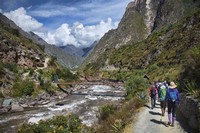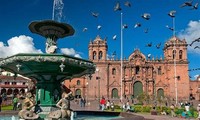Facts about Cusco

A Creole rebellion in the city of Huбnuco arose in 1812, and a rebellion in Cusco arose between 1814 and 1816.

Cusco's temperature is relatively consistent year-round, with average maximum daytime temperatures of 70°F (21°C), with July minimums of 30°F (-1°C).

The “Inca Trail” foot track is promoted as the best way to get to know Machu Picchu, which is approximately 62 miles to the northwest of Cusco.

Pachacuti is also believed to have built Machu Picchu on a mountain ridge 50 miles (80 km) northwest of Cusco, around 1460, as a family home, a retreat, or a fortress.

At Cusco's numerous restaurants, visitors can taste many spices and agricultural products, mostly organic, grown in traditional ways, frequently using ancient techniques such as the "Chaquitaclla" (foot plough).

Cusco's main stadium, Estadio Garcilaso de la Vega, is home to one of the country's most successful soccer clubs, Cienciano.

High in the Andes Mountains, Cusco's average elevation is around 11,150 feet (3,400 meters).

The name Cusco, which comes from a Quechua word (Qosqo) meaning navel or center "Qosqo" was transliterated into Spanish as "Cusco.

The living record that is Cusco serves as a reminder of an ancient civilization that displayed remarkable technical achievements in harmony with the natural environment.

Cusco was the capital of the extensive Inca Empire, and continues as a favorite destination for tourists seeking to explore Inca relics.

Under colonial rule, agriculture, cattle raising, mining, and trade with Habsburg Spain made Cusco prosperous.

The first Spaniards arrived in Cusco on November 15, 1533, and Pizarro who officially discovered the city on March 23, 1534, named it the "Very noble and great city of Cusco."

Cusco was found in 2006 to be the spot on Earth with the highest ultraviolet light level.

Cusco is the capital of the Cusco region, and of the Cusco province, one of the region's 13 provinces.

Cusco's local team has won several international competitions in South America.

The Inca people began as a tribe in the Cusco area around the 12th century C.E.

Cusco, the major cultural and population center of the Incan civilization, stands today as both a reminder of previous cultures and a modern functioning city.
Poroy is about 25 minutes by road from historical Cusco, and can be reached by local taxi or colectivo. The journey time by train is 3 hours and 20 minutes, and the train stops just once at Ollantaytambo Station before terminating at Aguas Calientes Once in Aguas Calientes you can take the shuttle bus to Machu Picchu.



